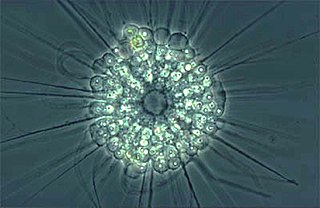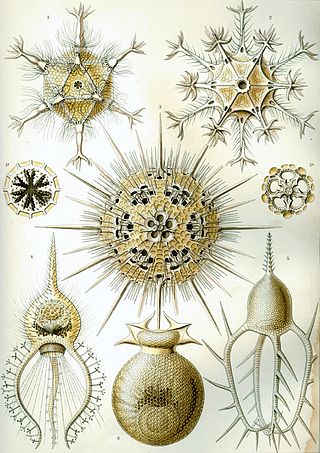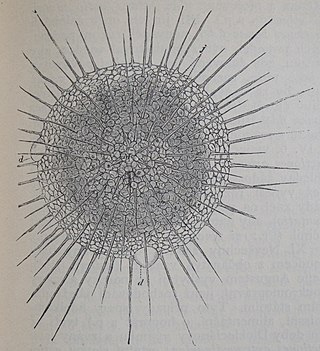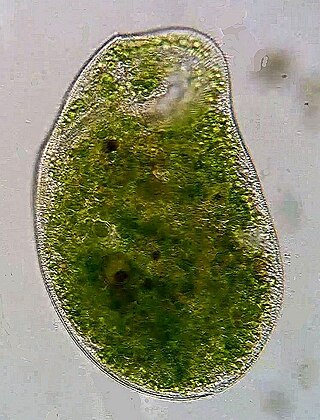
The actinophryids are an order of heliozoa, a polyphyletic array of stramenopiles, having a close relationship with pedinellids and Ciliophrys. They are common in fresh water and occasionally found in marine and soil habitats. Actinophryids are unicellular and roughly spherical in shape, with many axopodia that radiate outward from the cell body. Axopodia are a type of pseudopodia that are supported by hundreds of microtubules arranged in interlocking spirals and forming a needle-like internal structure or axoneme. Small granules, extrusomes, that lie under the membrane of the body and axopodia capture flagellates, ciliates and small metazoa that make contact with the arms.

Order Desmothoracida, the desmothoracids, are a group of heliozoan protists, usually sessile and found in freshwater environments. The adult is a spherical cell around 10-20 μm in diameter surrounded by a perforated organic lorica, or shell, with many radial pseudopods projecting through the holes to capture food. These are supported by small bundles of microtubules that arise near a point on the nuclear membrane. Unlike other heliozoans, the microtubules are not in any regular geometric array, there does not appear to be a microtubule organizing center, and there is no distinction between the outer and inner cytoplasm.

The Stramenopiles, also called Heterokonts, are a clade of organisms distinguished by the presence of stiff tripartite external hairs. In most species, the hairs are attached to flagella, in some they are attached to other areas of the cellular surface, and in some they have been secondarily lost. Stramenopiles represent one of the three major clades in the SAR supergroup, along with Alveolata and Rhizaria.

The centrohelids or centroheliozoa are a large group of heliozoan protists. They include both mobile and sessile forms, found in freshwater and marine environments, especially at some depth.

Pedinellales is a group of single-celled algae found in both marine environments and freshwater.

The axodines are a group of unicellular stramenopiles that includes silicoflagellate and rhizochromulinid algae, actinomonad heterotrophic flagellates and actinophryid heliozoa. Alternative classifications treat the dictyochophytes as heterokont algae, or as Chrysophyceae. Other overlapping taxonomic concepts include the Actinochrysophyceae, Actinochrysea or Dictyochophyceae sensu lato. The grouping was proposed on the basis of ultrastructural similarities, and is consistent with subsequent molecular comparisons.

Christian Gottfried Ehrenberg was a German naturalist, zoologist, comparative anatomist, geologist, and microscopist. Ehrenberg was an evangelist and was considered to be one of the most famous and productive scientists of his time.

Heliozoa, commonly known as sun-animalcules, are microbial eukaryotes (protists) with stiff arms (axopodia) radiating from their spherical bodies, which are responsible for their common name. The axopodia are microtubule-supported projections from the amoeboid cell body, and are variously used for capturing food, sensation, movement, and attachment. They are similar to Radiolaria, but they are distinguished from them by lacking central capsules and other complex skeletal elements, although some produce simple scales and spines. They may be found in both freshwater and marine environments.

Phaeodarea or Phaeodaria is a group of amoeboid cercozoan organisms. They are traditionally considered radiolarians, but in molecular trees do not appear to be close relatives of the other groups, and are instead placed among the Cercozoa. They are distinguished by the structure of their central capsule and by the presence of a phaeodium, an aggregate of waste particles within the cell.

Actinosphaerium is a genus of heliozoa, amoeboid unicellular organisms with many axopodial filaments that radiate out of their cell. It is classified within the monotypic family Actinosphaeriidae and suborder Actinosphaerina. Species of Actinophrys are distinguished by their large number of nuclei in each cell. Their axopodia sometimes terminate on the surface of nuclei. Vacuoles are abundant in the periphery of the cytoplasm.

Raphidiophrys is a genus of centrohelid with radiating axopodia. R. intermedia is found in the bottom sludge of freshwater bodies in Canada, Chile, Argentina, Australia, New Zealand, Malaysia, Russia, and central Europe. Raphidiophrys have bipartite scales are a defining characteristic among species. Differences in type and size of scales are used to differentiate amongst the members of this genus. The genus Raphidiophrys was discovered in 1867 by W. Archer. Raphidiophrys is one of very few centrohelids in which dimorphism has been shown.

Dictyocha is a genus of silicoflagellates, marine photosynthetic unicellular protists that take the form of either flagellates or axopodial amoebae. Described by Ehrenberg in 1837, Dictyocha contains many important species of the marine phytoplankton, some of them responsible for algal blooms that are toxic to fish.

Lacrymaria is a genus of ciliates. Its best known species is the "Tear of Swan", Lacrymaria olor.

Climacostomum virens is a species of unicellular ciliate protists. It is one of just two formally described species in the genus Climacostomum.

Kiitoksia is a genus of aquatic protist. The taxonomic position of the genus is still uncertain and it has not found a robust location in any subgroup.

An amoeba, often called an amoeboid, is a type of cell or unicellular organism with the ability to alter its shape, primarily by extending and retracting pseudopods. Amoebae do not form a single taxonomic group; instead, they are found in every major lineage of eukaryotic organisms. Amoeboid cells occur not only among the protozoa, but also in fungi, algae, and animals.

Granofilosea is a class of cercozoan protists in the subphylum Reticulofilosa. Out of the three groups that were traditionally considered heliozoans: the heliomonads, gymnosphaerids and desmothoracids, the latter were recently grouped into this new class.

Raphidomonadea is a class of Stramenopiles containing both photosynthetic and phagotrophic protists. The phagotrophic groups are known as Raphopoda, and comprise actinophryid heliozoa and the marine genus Commation. The photosynthetic groups are known as the raphidophyte algae. Their relationship was elucidated through phylogenetic analyses.

Ultrastructural identity is a concept in biology. It asserts that evolutionary lineages of eukaryotes in general and protists in particular can be distinguished by complements and arrangements of cellular organelles. These ultrastructural components can be visualized by electron microscopy.
Heliorapha is a genus of heliozoan protists, amoeboid eukaryotes with stiff axopodia radiating from their cells. It contains one species, Heliorapha azurina. It is classified within a monotypic family Helioraphidae inside the actinophryids, a group of heliozoa that belong to the Ochrophyta along with other protists such as diatoms and brown algae.

















